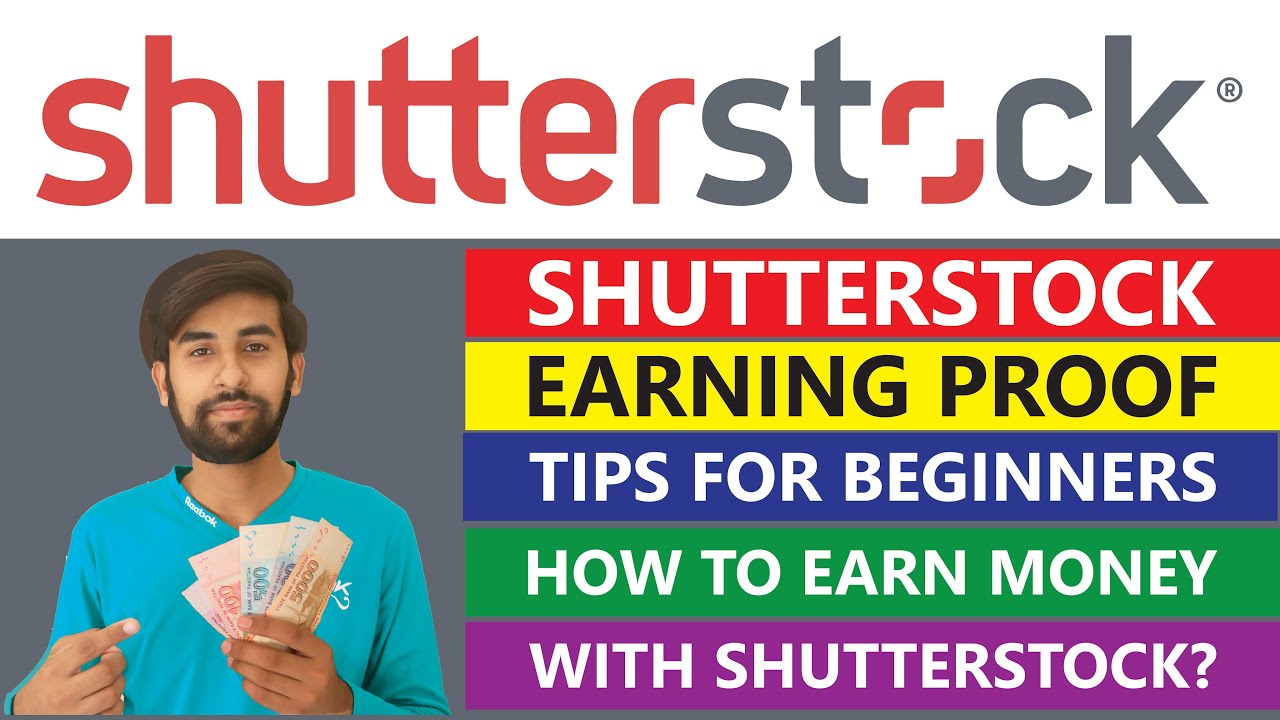If you’re a photographer or graphic designer interested in selling your work online, Shutterstock might be on your radar. But how exactly does their revenue model work? In simple terms, Shutterstock operates as a marketplace connecting content creators with millions of customers worldwide. When someone downloads your image or video, you earn a commission. The platform manages licensing, payments, and distribution, making it a convenient way for artists to monetize their portfolios. Understanding this model helps you know what to expect and how to optimize your earnings. Let’s dive into the details of how
How Shutterstock Pays Contributors

Shutterstock‘s payment system is straightforward but has some nuances worth understanding. As a contributor, you earn a percentage of the sale price whenever your content is downloaded. The exact percentage varies depending on your contributor level and whether you’re on a standard or enhanced license. Typically, royalty rates range from around 15% to 40% of the download fee.
Here’s a quick overview:
- Standard License Downloads: Contributors earn a lower percentage, usually between 15-30%, depending on their contributor level.
- Enhanced License Downloads: These generally pay higher royalties, often around 30-40%, because they allow more extensive use of the content.
Shutterstock also offers a tiered contributor program. As you upload more quality content and generate more sales, your earning percentage can increase. Your earnings are accumulated in your Shutterstock account, and once you reach the minimum payout threshold (usually $35), you can request a payout via PayPal, Skrill, or bank transfer.
It’s important to note that Shutterstock‘s licensing model also influences your earnings — the more licenses your images sell, the more you earn. Plus, the platform’s global reach means your work can be downloaded and licensed worldwide, potentially increasing your income over time.
In summary, Shutterstock pays contributors based on a percentage of each sale, with the potential for higher earnings as you grow your portfolio and reputation on the platform. Knowing how this system works can help you strategize to maximize your revenue and turn your creative efforts into a steady income stream.
Factors Affecting Earnings Per Sale
When it comes to understanding how much you can earn from each sale on Shutterstock, it’s important to realize that several factors come into play. Your earnings per sale aren’t fixed; they fluctuate based on various elements, including your contributor level, the type of license purchased, and even the specific content you upload.
First off, your contributor level makes a big difference. Shutterstock has different tiers—Contributor, Elite Contributor, and so on—and as you progress through these levels, your earnings per sale can increase. This is often tied to your overall sales volume and quality of content.
Next, the type of license purchased significantly impacts your payout. Shutterstock offers two main types of licenses:
- Standard License: Usually used for personal projects, blogs, or small commercial uses. The payout per sale is generally lower.
- Enhanced License: Suitable for larger commercial uses, such as billboards or product packaging. These licenses typically come with a higher payout per sale.
Another key factor is the content category. For example, images and vectors tend to generate different earnings compared to videos or editorial content. Videos often have higher payout rates because they’re more complex to produce and license.
Additionally, the exclusivity of your content can influence earnings. If you choose to license your content exclusively through Shutterstock, you might benefit from higher payout rates or bonuses, depending on the program terms. Non-exclusive content, while allowing you to sell elsewhere, might earn you slightly less per sale.
Finally, geographic location and buyer type can play a role, although these are less directly controllable factors. Large corporate clients or agencies tend to purchase higher-value licenses, which can bump up your earnings per sale when you’re selling to them.
In summary, your earnings per sale are affected by your contributor ranking, license type, content category, exclusivity choices, and the specific buyer. Understanding these factors helps you strategize better and optimize your content to maximize your earnings.
Average Earnings for Shutterstock Contributors
If you’re just starting out or considering becoming a Shutterstock contributor, you probably want to know what kind of earnings to expect on average. While individual results vary widely, it’s helpful to get a sense of the typical earnings landscape.
On average, contributors earn around $0.25 to $0.35 per download for standard licenses, which is the most common type of sale. However, this number can increase significantly for enhanced licenses, often ranging from $1 to over $10 per sale, especially for high-demand content like videos or exclusive images.
For new contributors, the initial earnings per sale tend to be lower, but as you upload more content and build your portfolio, your sales volume and earnings can grow. Many successful contributors report earning between $50 to $200 per month when they’re just starting, with top earners making several thousand dollars monthly.
It’s also worth noting that your total income depends on how much you sell. For example:
| Number of Sales | Estimated Monthly Earnings |
|---|---|
| 10 sales | $3 to $50 |
| 50 sales | $12.50 to $175 |
| 200 sales | $50 to $700 |
Remember, these are rough estimates, and individual earnings can vary based on license type, content quality, and other factors we discussed earlier. The key takeaway is that consistency and quality matter. The more high-quality content you upload, the more potential there is for earning higher amounts over time.
Many contributors find success by focusing on niche content, trending topics, or creating unique, high-demand visuals. With patience, dedication, and strategic uploads, earning a steady income from Shutterstock is definitely within reach.
Tips to Maximize Your Income on Shutterstock
So, you’re eager to boost your earnings on Shutterstock? That’s a smart move! The good news is, with a few strategic steps, you can increase your sales and make the most out of your creative efforts. Let’s dive into some practical tips to help you maximize your income on this platform.
Focus on Popular and Trending Topics
One of the easiest ways to get more sales is to create content that aligns with current trends and popular subjects. Keep an eye on what buyers are searching for—whether it’s seasonal themes, current events, or niche topics gaining traction. Shutterstock’s search data and trending collections can give you clues about what’s in demand right now.
Optimize Your Keywords and Descriptions
Think of keywords as the bridge between your content and potential buyers. Use relevant, specific, and high-traffic keywords to describe your images or videos. Write clear, engaging descriptions that highlight the key features. The better your metadata, the higher your content ranks in search results, increasing your chances of sales.
Upload Consistently and Maintain Quality
Regular uploads keep your portfolio fresh and show Shutterstock that you’re an active contributor. While quantity matters, don’t compromise on quality. High-resolution, well-composed, and professionally edited content performs better and attracts more buyers. Invest time in editing and reviewing your work before uploading.
Specialize in a Niche
While broad portfolios can be beneficial, specializing in a niche—like healthcare, technology, or specific lifestyle themes—can help you stand out. Niche content often has less competition and higher demand within specific buyer segments, leading to better earnings per sale.
Engage with the Community and Learn
Join Shutterstock forums, social media groups, or webinars. Learning from other contributors’ experiences and sharing tips can give you insights into what works. Plus, engaging with the community can motivate you and keep you inspired to create fresh, relevant content.
Offer a Variety of Content Types
Explore different formats—photos, videos, vectors, and illustrations. Some buyers prefer one format over another, so diversifying your offerings can open more sales opportunities. Experiment with different styles and subjects to see what resonates best.
Conclusion and Final Thoughts on Shutterstock Revenue Potential
Understanding Shutterstock’s earnings per sale is just the beginning of your journey as a contributor. While the platform offers a fantastic opportunity to turn your creativity into income, success doesn’t happen overnight. It requires strategic planning, consistent effort, and a keen eye for what buyers want.
The potential for earning on Shutterstock is quite promising, especially as your portfolio grows and you refine your skills. Remember, each sale not only adds to your income but also boosts your credibility and visibility on the platform. By applying the tips we discussed—such as optimizing your content, staying current with trends, and diversifying your portfolio—you can significantly increase your revenue over time.
Keep in mind that earnings per sale vary depending on several factors, including your contributor level, the type of content, and licensing options. Patience and persistence are key. Celebrate the small victories along the way and keep learning from your experiences and the wider contributor community.
In the end, Shutterstock can be a rewarding platform for passionate creators willing to put in the effort. With dedication and smart strategies, you can unlock your full earning potential and turn your creative passions into a sustainable income stream. Happy creating!


